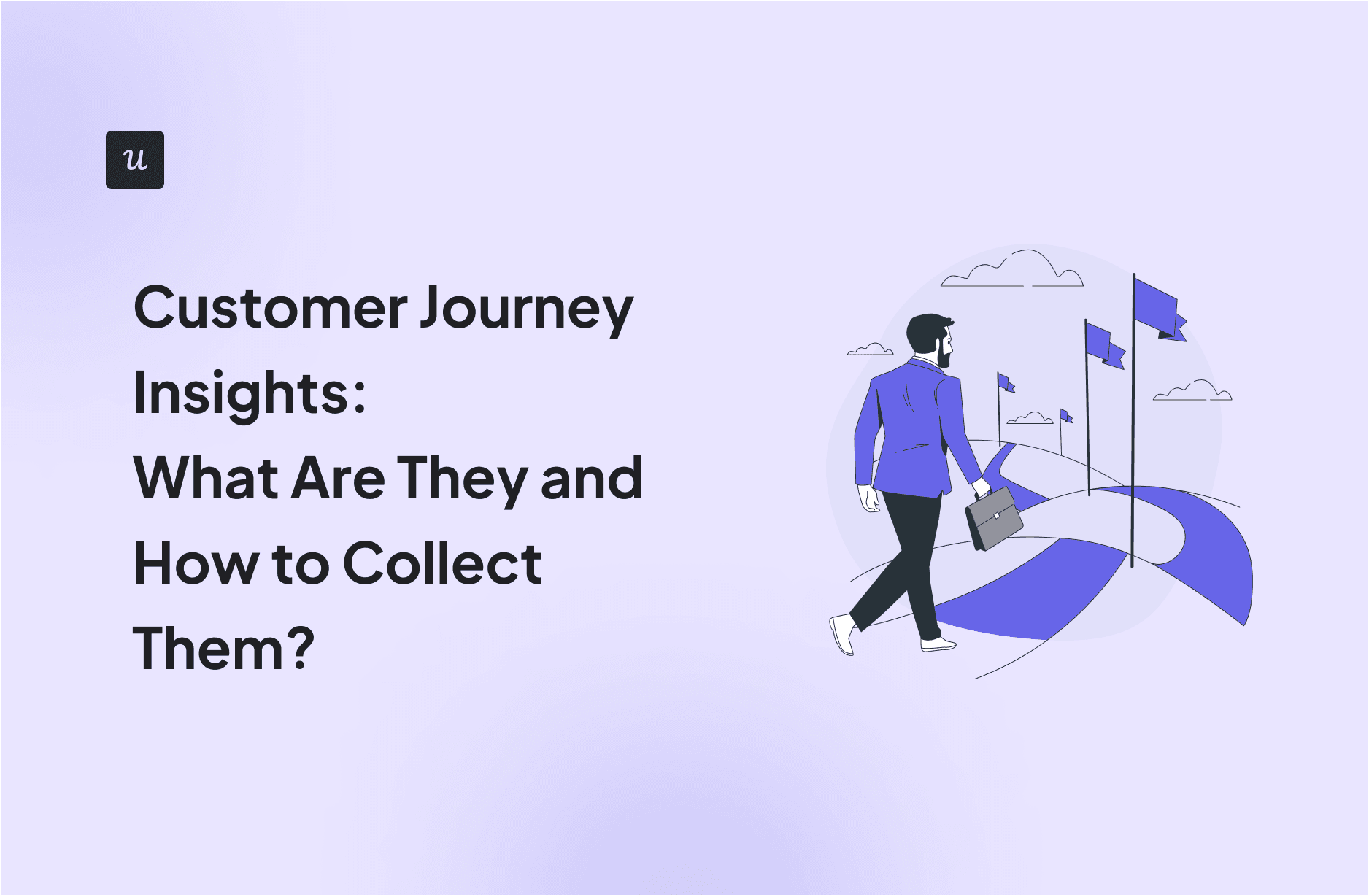
Customer journey insights enable marketing, product, design, and customer success teams to make informed decisions and create better customer experiences.
In this article, we explain:
- What customer journey insights are.
- How they are linked to customer journey analysis and customer journey mapping.
- Why you should use customer journey analytics.
- How to extract and use them to optimize the customer journey.
We also look at the best analytics tools for analyzing customer journeys.
Try Userpilot Now
See Why 1,000+ Teams Choose Userpilot

Summary of customer journey insights
- Customer journey insights are what you learn from analyzing customer behavior at different stages of the journey.
- The objective of customer journey analytics is to track and interpret user actions to get such insights, and customer journey mapping is an essential part of the process.
- Customer journey analysis enables companies to identify friction points in the journey that prevent users from converting and lead to customer dissatisfaction or even churn.
- Typical customer journey stages are Awareness, Consideration, Decision, Activation, Adoption, Renewal, Expansion, and Loyalty.
- Start the customer journey analysis process by setting clear goals.
- Next, map out the journey for all user personas, focusing on key touchpoints, events, and pain points.
- In the next step, use analytics and feedback tools to collect customer data.
- Start analyzing the data by conducting funnel and path analysis. Zero in on specific behaviors with session recordings.
- Use the insights to optimize the problematic touchpoint, for example, with in-app experiences.
- Test the effectiveness of the optimizations by tracking their impact and running experiments. Tweak them as you go.
- User insights are used to personalize their experiences, for example, by tailoring the onboarding flows to their use cases.
- Thanks to the insights, you can target the right users with upsell and cross-sell messages at the right time.
- Journey analytics insights also help teams predict churn and tackle churn drivers proactively.
- Userpilot is a product growth platform with excellent analytics. Book the demo to see how to use it for customer journey analysis.
What are customer journey insights?
Customer journey insights are the conclusions you make when you analyze user interactions with your product across all customer touchpoints: from the moment they first learn about it until they become its loyal advocates and beyond.
These insights provide a deep understanding of customer behavior, needs, and problems and enable teams to optimize product messaging, marketing campaigns, in-app product experiences, and customer support processes.
Customer journey mapping vs. customer journey analytics vs. customer journey insights
These three terms are all closely connected and play an important role in the customer journey optimization process.
Customer journey mapping visualizes the customer path with your product or brand. It focuses on the key journey stages, main touchpoints, user actions, and associated challenges and emotions.
Customer journey analytics focuses on tracking, analyzing, and interpreting customer actions and behaviors across this path.
Customer journey insights are the actionable findings drawn from analytics. They guide decision-making and strategy optimization to enhance the customer experience.
Why is it important for companies to analyze customer journey maps?
Customer journey map analysis enables teams to identify opportunities to drive product and business success.
Identify potential pain points and friction points in the user journey
Analyzing customer journey maps allows companies to pinpoint where customers experience difficulties.
By optimizing the relevant touchpoints and addressing customer pain points, SaaS teams can reduce time to value and improve the overall customer experience.
Improve conversion rates across different customer journeys
Friction doesn’t only slow down users but often prevents them from reaching the next stage in the customer journey. For example, a lengthy sign-up process can put customers off.
Insights gained from journey analysis help identify such barriers to conversion and streamline the journey for better conversion rates.
Improve customer satisfaction and retention
Understanding the customer expectations and pain points at different stages of their journey enables teams to make improvements leading to higher success rates.
This translates into higher customer satisfaction and loyalty, and directly impacts retention and customer lifetime value.
What are the different stages of the customer journey map?
The exact stages of the customer journey depend on your product or service.
A typical SaaS customer journey may consist of stages like:
- Awareness – when the user finds out about the product.
- Consideration – when it starts evaluating it as a potential solution to their problem.
- Decision – when they purchase the product.
- Activation – when they start using the product to achieve their goals.
- Adoption – when the product becomes their go-to solution.
- Renewal – when they decide to renew their subscription.
- Expansion – when they upgrade to a higher plan or buy add-ons.
- Loyalty – when the relationship with the business is mature and mutually beneficial.

How to analyze the entire customer journey to drive actionable insights?
With the basics covered, let’s jump into our step-by-step guide to the customer journey analytics process.
1. Define your goals before conducting customer journey analysis
Before you start the journey analysis process, answer one key question: what do you want to achieve? Do you want to improve a specific metric, like user activation?
If so, start by setting a specific goal. This will help you focus on the right stages of the customer journey and choose the right tools for the job. Consider using a framework like SMART to ensure they are specific, measurable, and achievable within the allocated timeframe.
Narrowing down your scope like that isn’t always a good idea. If it’s your first customer journey analysis, adopt a more holistic approach. That’s how you identify the most urgent areas for improvement or pick some low-hanging fruit.

2. Map out the complete customer journey
A user journey map is a visualization of:
- Key user journey stages (awareness, consideration, etc.).
- Main touchpoints (PPC ad, landing page, etc.).
- User actions (e.g., complete the sign-up form).
- Challenges/pains (e.g., don’t know where to start after the first login).
- Emotions (excitement, confusion, etc.).
You may need a different customer journey map for each user persona because they use the product to achieve unique goals.
Take Surfer as an example: an SEO manager needs more features than a writer.

3. Collect customer data from multiple channels
To collect customer data, you need a customer journey analytics solution. In fact, to cover all touchpoints, you’re likely to need more than one.
For example, Userpilot offers advanced analytics capabilities, but you can’t use it to track user behavior on your website or mobile app.
In most tools, you collect data by tracking features and events. This is done either by attaching JS script to the feature from the back end or tagging them from the front end, like in many modern no-code tools. In Userpilot, you do it from the Chrome extension.
To get a complete picture of user motivations and preferences, try combining customer journey analytics with feedback.

4. Analyze behavior across important customer interactions
Once you have the customer data, you can analyze it. The choice of tools depends on your objectives.
Let’s imagine it’s the first time you’re analyzing the customer journey in your product and you want to identify opportunities for optimizing it.
Funnel analysis is a good place to start. The report allows you to assess how smoothly users progress from one stage of the customer journey to another and identify areas where they experience friction.
If there’s a particular stage you want to drill down on, move on to path analysis. This enables you to map user actions and identify the most common paths leading to or following conversion events. That’s how you can pinpoint specific friction points and find the happy paths to conversion.
For even more granular insights, use session recordings. These tools enable you to analyze user behavior on a specific page or screen, which makes it easier to get to the root cause of the issue.

5. Act on customer behavior insights
The customer journey insights are only as good as the action that follows.
How do you act on the insights?
There are plenty of things that could be causing friction, and this determines the solutions you implement.
For example, if your users cannot find an important feature or a button on the page necessary to complete a process, you can help them with a tooltip or hotspot.

6. Iterate on your strategies to drive continuous improvement
After implementing the solution, track its impact to see if it increases engagement and reduces the drop-off rates.
This doesn’t mean your job is done. There’s usually room for improvement, and it takes a few iterations to nail it.
A/B tests are a popular technique used to check the performance of new features against the original solution. In the test, you enable 2 versions of a feature to half of the same user sample and track how they perform.
If you’d like to test more versions, use multivariate tests instead. This reduces the number of experiments you have to conduct to reach a conclusion.
It’s good practice to test product changes on small user samples before rolling them out for the whole user base, to reduce potential disruptions.

How to use customer journey insights to improve the customer experience?
As mentioned, there are multiple ways to use customer journey insights to improve the customer experience and improve your metrics. Let’s have a look at 3 of them in more depth.
Create personalized customer experiences
With customer insights, you can personalize the customer experience at every stage of the journey.
Here’s a quick example:
By analyzing the paths that users take inside the product, you’ve identified the most optimal route to activation for the main user segments.
With such insights, you can personalize the onboarding flows to lead them to value quickly.
Once a new user signs up for the product, a welcome survey helps you segment them and trigger the relevant flow.
Other examples of customer experience include:
- Marketing campaigns highlight features relevant to a particular user persona.
- Dedicated landing pages for different use cases.
- User interfaces are customized for easy access to show important features or templates.

Identify and trigger upsell messages to the right segments
Customer journey insights can help you boost the effectiveness of your account expansion efforts.
By analyzing how users interact with the product, you can identify the right moment to engage them. For example, the insights can reveal that the most effective upsell messages are contextual and appear when the customer normally uses a specific feature.
It doesn’t mean that all users should be targeted with such in-app messages.
Some of them may not be ready to appreciate the value of the premium features because they haven’t adopted more basic functionality yet. You can find out when the user is ready by analyzing the paths leading to upgrades.

Predict customer behavior to reduce customer churn
Customer journey insights are crucial for reducing user churn. By removing roadblocks from the customer journey, you enable users to realize product value and achieve their goals, which reduces the risk they leave.
It doesn’t stop there.
The analysis of user behavior leading to churn can often help you find regularities that you can use to prevent it. For example, your path analysis can reveal a sequence of actions before the user disappears for good.
Knowing that, you can engage the users proactively to make them stick around.
For example, you can create a custom event consisting of the actions leading to churn and use it to trigger a survey or an in-app message prompting them to engage with a specific feature.

Best tools for leveraging customer journey analytics
As mentioned, to derive insights from a customer’s journey, you need the right software. Here are 3 customer journey analytics tools to consider.
Userpilot
Userpilot is a digital adoption platform. This means you can use it to analyze user journeys inside an app, collect customer feedback, and act on the insights by creating interactive in-app experiences.
Its analytics features include:
- User segmentation – essential for personalization and targeted engagement.
- Feature and (custom) event tagging.
- Funnel analysis – for high-level customer journey analysis.
- Path analysis – for in-depth user journey insights.
- Trend and retention analysis
- Flow analytics – to measure the impact of in-app patterns.
- A/B and multivariate testing.
- Integrations with analytics tools, including Google Analytics, Amplitude, Mixpanel, and Heap.

Google Analytics
Google Analytics is a free analytics platform that allows you to track and analyze user interactions throughout customer journeys. However, most teams use it for web analytics.
GA supports funnel and path analysis (called explorations). This can be used to analyze user flow through your website, so you can optimize it for better conversions.
It also offers you insights into the origins of your traffic (referral, organic, paid) for effective allocation of resources to different channels. Finally, its demographics reports can shed light on who your customers are and where they come from.
The tool offers integrations, including Google Adsense, so you can track the performance of your PPC campaigns.

Amplitude
Amplitude is a dedicated analytics platform with powerful capabilities.
These include:
- Segmentation.
- Funnel and user journey analysis.
- Conversion drivers – to identify behaviors that lead to conversions or drop-offs.
- Cohort analysis.
- Root cause analysis.
- Campaign reporting – to track the performance of your acquisition efforts.
- Cart analysis – for customer purchase behavior understanding.
Just like Google Analytics, you can use Amplitude to track user behavior on your websites and inside mobile and web apps. However, neither of the tools offers an engagement layer, so you need a 3rd party tool to act on the customer journey insights.

Conclusion
Thanks to customer journey insights, your teams can optimize the customer experience to ensure that users progress down the funnel smoothly and achieve their objectives with ease.
Tracking user behavior and analyzing the data for actionable insights requires a certain level of experience in data analysis—at least it used to, since modern no-code tools like Userpilot make data more accessible to non-technical users.
Don’t believe me? Book the demo to see how easy and intuitive customer journey analysis can be.







